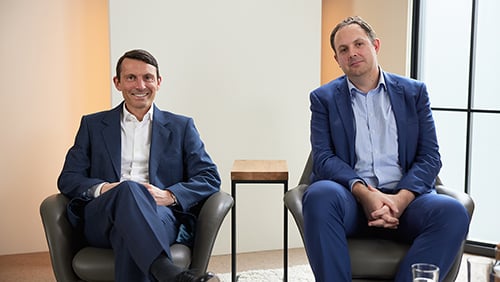Long-term endurance
Lawrence Burns – Deputy manager, Scottish Mortgage
We believe that the long time horizon with which we approach investing is the source of much of our distinctiveness and edge.

The value of shares in Scottish Mortgage, and any income from them, can fall as well as rise and investors may not get back the amount invested.
There are a great many investors and commentators focused on the short term. Consequently, our ability to derive an edge from such matters is limited. An inordinate number of very smart people are already committed to that task. Part of the challenge with trying to add value over short time horizons is that you are competing against so many people in the same crowded pursuit. However, if you are able to withstand the behavioural and institutional pressures that come with operating over far longer time horizons then you can dramatically reduce the number of people you are competing with. This in turn makes the possibility of edge and genuine difference to the market far greater.
We make our investment decisions by considering a company’s prospects over a decade and certainly no less than five years. We believe this is radically different to the average market participant. In doing so it aligns us with the fundamental progress of companies rather than the fashions of markets. After all, it takes many years for large market opportunities to be seized, for formidable competitive advantage to be recognised and for the vision of founders to come to fruition.
Long and winding roads
What makes long-term investing difficult is that progress is rarely a straight-line. Genuine long-term investing requires not just patience but the ability to endure periods of intense discomfort. We have experienced such discomfort often with our holdings. Tesla was first purchased by Scottish Mortgage in January 2013. It experienced a fall of 40 per cent that first year alone. During the course of our ownership, it has now fallen by 30 per cent or more on seven occasions. Yet more extreme was NIO, the Chinese electric car maker. It endured a near 90 per cent drawdown in the year following its IPO before experiencing its tremendous rise. Our other significant contributors to long-term performance such as Amazon, Illumina and Tencent have all been subjected to discomforting drawdowns during their time in the portfolio. The returns generated by these companies could easily have been forgone if the endurance of steep share price declines had not been weathered. Giving up on Tesla, on any one of those seven occasions, would have been catastrophic to the returns of Scottish Mortgage shareholders.
The work of Professor Hendrik Bessembinder, examining the last seven decades of US equity returns, shows us our own examples are not unusual but representative. He notes “even those investments that are the most successful at long horizons involve painful losses over shorter horizons” with drawdowns of 40 per cent or more shown to be common and often lasting around a year.
We therefore know that significant drawdowns are a normal part of long-term investing. Nevertheless, that does not dispel the uncertainty that inevitably accompanies each occasion. We must always consider the possibility that the world has changed and that our investment case is no longer valid. We have never made a single investment we were certain would be successful. This is why endurance in investing is so difficult. It is endurance not with the certainty that we are right but with the acceptance that we could in the fullness of time turn out to be wrong.
We must therefore engage in honest reflection during periods such as this. The primary mechanism through which we do so is by returning to our scenario analysis and updating as appropriate. For each holding we sketch out a range of possible scenarios as to how a company might look in five to ten years. Usually, those scenarios will range from zero to a very high figure. It is the likelihood adjusted returns from those different scenarios that determines whether we add, hold or redeploy our shareholders’ capital elsewhere. As you would expect we have revisited our holdings’ future scenarios as they have come under pressure.
The drawdowns of today
Moderna has experienced a 70 per cent fall from the highs of last year. While the market focus has been on the longevity of Covid vaccine revenues we have felt this overlooks the progress being made to apply its mRNA technology to a broader range of healthcare problems such as flu, Zika, HIV and even cancer. It is hard to argue significant value is being placed upon that broader potential platform when the company is valued by the market on a mere five-times earnings and has nearly one-third of its market cap in cash. We have therefore used the falls in the share price to add. This has in large part been funded by reductions to Amazon and Tesla.

Delivery Hero, is a local delivery company headquartered in Berlin but operating across 50 countries around the world from Argentina to Singapore. It suffered a particularly precipitous fall in its share price. Nonetheless, when re-visiting our investment case and accompanying scenario analysis we assessed that, if anything, the likelihoods of success may have actually increased. Our biggest concern had been competition in the key market of South Korea. Nonetheless, the most recent evidence is that it is growing rapidly and continuing to hold its near 80 per cent market share in the country. Looking across all the markets it operates in revenues grew over 50 per cent annually in the first three months of this year with a significant long-term growth opportunity still remaining. Continued progress does not appear to be recognised by the market. Indeed, over the last two years revenues have increased nearly four-fold and yet the share price has fallen over 50 per cent during that same period.
We would far rather endure painful drawdowns such as these than too readily abandon the companies and founders that have the potential to deliver the rare outlier returns we seek. We remain deeply enthused by some of the long-term changes we are seeing in the world and the companies bringing those changes to life. The continuing digitisation of our society, the intersection of biology and information technology and the much-needed energy transition, each offer tremendous long-term structural opportunities.

Of course, our reaction to some drawdowns will still be to conclude that the investment case is not developing as hoped. This was the case with CureVac, the German biotechnology company which we held for six years starting as a private company. The lack of progress in multiple clinical trials compounded with several disconcerting management changes led us to ascribe a substantially lower likelihood of success and we therefore divested last summer.

A continued commitment to being long term
Long-term endurance in turbulent times such as those of the last few months can be challenging. In periods of stress people’s time horizons contract, and the pressure to sacrifice long-term gains for immediate respite grows by the day. Should our time horizon ever meaningfully shorten we would be destroying our greatest advantage. We have no intention of ever doing this but if we did our shareholders should sell. For it is precisely at such difficult times that the distinctiveness, and importance, of taking a long-term perspective is greatest – for us as investors, for the companies in which we invest, and for our shareholders. We are deeply appreciative of the trust our shareholders place in us, and of their support in our task.
Annual Past Performance to 31 March Each Year (Net %)
| 2018 |
2019 |
2020 |
2021 |
2022 |
|
| Scottish Mortgage Investment Trust |
21.0 | 16.5 | 12.7 | 99.0 | -9.5 |
Risk Factors
The trust invests in overseas securities. Changes in the rates of exchange may also cause the value of your investment (and any income it may pay) to go down or up.
The trust invests in emerging markets where difficulties in dealing, settlement and custody could arise, resulting in a negative impact on the value of your investment.
The trust has significant exposure to private companies. The Trust’s risk could be increased as these assets may be more difficult to buy or sell, so changes in their prices may be greater.
About the author - Lawrence Burns
Deputy manager, Scottish Mortgage
Lawrence Burns was appointed deputy manager of Scottish Mortgage in 2021. He joined Baillie Gifford in 2009 and became a partner of the firm in 2020. During his time at the firm, his investment interest has become focused on transformative growth companies. He has been a member of the International Growth Portfolio Construction Group since October 2012 and in 2020 became a manager of Vanguard’s International Growth Fund. Lawrence is also co-manager of the International Concentrated Growth and Global Outliers strategies. Prior to this, he also worked in both the Emerging Markets and UK Equity teams. Lawrence graduated BA in Geography from the University of Cambridge in 2009.
Important information
This communication was produced and approved at the time stated and may not have been updated subsequently. It represents views held at the time of production and may not reflect current thinking.
This content does not constitute, and is not subject to the protections afforded to, independent research. Baillie Gifford and its staff may have dealt in the investments concerned. The views expressed are not statements of fact and should not be considered as advice or a recommendation to buy, sell or hold a particular investment.
Baillie Gifford & Co and Baillie Gifford & Co Limited are authorised and regulated by the Financial Conduct Authority (FCA). The investment trusts managed by Baillie Gifford & Co Limited are listed on the London Stock Exchange and are not authorised or regulated by the FCA.
A Key Information Document is available by visiting our Documents page.
Any images used in this content are for illustrative purposes only.








